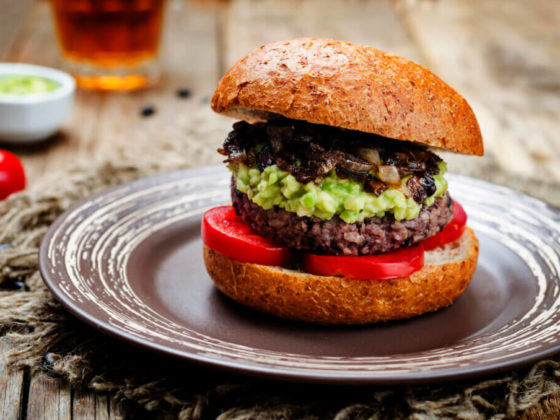Tutu de Feijão is a typical Brazilian dish that is a must-try if you’re a bean lover! Rich and hearty, it is absolutely delicious and very easy to make.
Recipe courtesy of Olivia Mesquita, blogger at Olivia’s Cuisine.
BETTER THAN REFRIED BEANS!
I have yet to meet a Brazilian that is not crazy for rice and beans.
From feijoada to caldinho de feijão, beans are a huge part of our cuisine and one of the first things we learn how to cook!
So when the US Dry Beans Council invited me to share a recipe to celebrate World Pulses Day, I knew it was time for my Tutu de Feijão to make its debut here on the blog.
World Pulses Day is a designated United Nations event that happens on February 10th to recognize the importance of pulses (chickpeas, dry beans, lentils, and others) as an excellent source of protein and nutrition.
I can’t think of a better dish to celebrate this day!
Creamy and hearty, Tutu de Feijão is not only nutritious but also one of Brazil’s most beloved comfort foods. Accompanied by rice and collard greens, it can soothe even the most anxious soul!
WHAT IS TUTU DE FEIJÃO?
Tutu de feijão is a Brazilian dish made of puréed beans and thickened with cassava flour. It is popular all over Brazil, but mostly associated with the state of Minas Gerais, hence why it is also called Tutu à Mineira.
The word “tutu” comes from the Kimbundu (one of the two Bantu languages and the second-most-widely spoken Bantu language in Angola) word ki’tutu.
Unfortunately, I couldn’t find its meaning. However, knowing the origins of the word, gives us the important clue that the dish originated from African slaves. After the masters had dined, all that would be left for the slaves to eat was the remaining bean liquid at the bottom of the pot. So they would thicken it with cassava flour, creating what is now a famous Brazilian dish.
Once the tutu made its way to the slave-owner’s tables, it gained other ingredients, like bacon and/or sausage.
INGREDIENTS FOR TUTU DE FEIJÃO
To make Brazilian Refried Beans, you will need:
- Beans
- Bacon
- Onion
- Garlic
- Olive Oil
- Parsley
- Bay Leaves
- Salt and Pepper
- Cassava Flour
WHAT KIND OF BEANS ARE USED FOR TUTU DE FEIJÃO?
Tutu à Mineira is traditionally made with either black or carioca beans.
While this recipe calls for the black variety, I usually make it with whatever kind I have on hand. Black beans, pinto beans and even white beans – they are all great for Tutu de Feijão!
Being Brazilian, my pantry is constantly stocked with several kinds of beans. The U.S. grows more than 10 varieties of beans, so I can always find what I need to make the dishes from my home country!
Thanks to state-of-the-art harvesting equipment, handling practices and production processes, the United States is the global leader in dry bean production, planting from 1.5 to 1.7 million acres of edible dry beans per year.
WHAT IS CASSAVA FLOUR?
Cassava Flour, also known as Manioc Flour or Yuca Flour, is made from the whole root of the cassava plant.
Cassava is a tropical plant that bears an tuberous root that is rich in carbohydrates and used in many South American dishes, both sweet and savory.
The mild flavored root is dried and ground to produce cassava flour, a great alternative for gluten free cooking and baking. In Brazil, it is often used to make farofa or simply sprinkled over beans!
This flour is gaining momentum in the U.S. as a gluten-free alternative, so I’m hoping we will soon be able to easily find it at all grocery stores. However, for now, you can find it at Brazilian stores or online.
ARE CASSAVA AND TAPIOCA FLOUR THE SAME?
No, they are not.
While they both come from the same plant and are sometimes used interchangeably, they are different products with different applications.
Tapioca flour is the bleached and extracted starch from the cassava root. It is usually used as a thickener due to its high starch content.
Cassava flour, or Farinha de Mandioca, is just the ground-up root. It contains lots of fiber, making it ideal for more structured dishes.
WHAT CAN I USE IF I CAN’T FIND MANIOC FLOUR?
You can use fine corn flour or finely ground breadcrumbs instead.
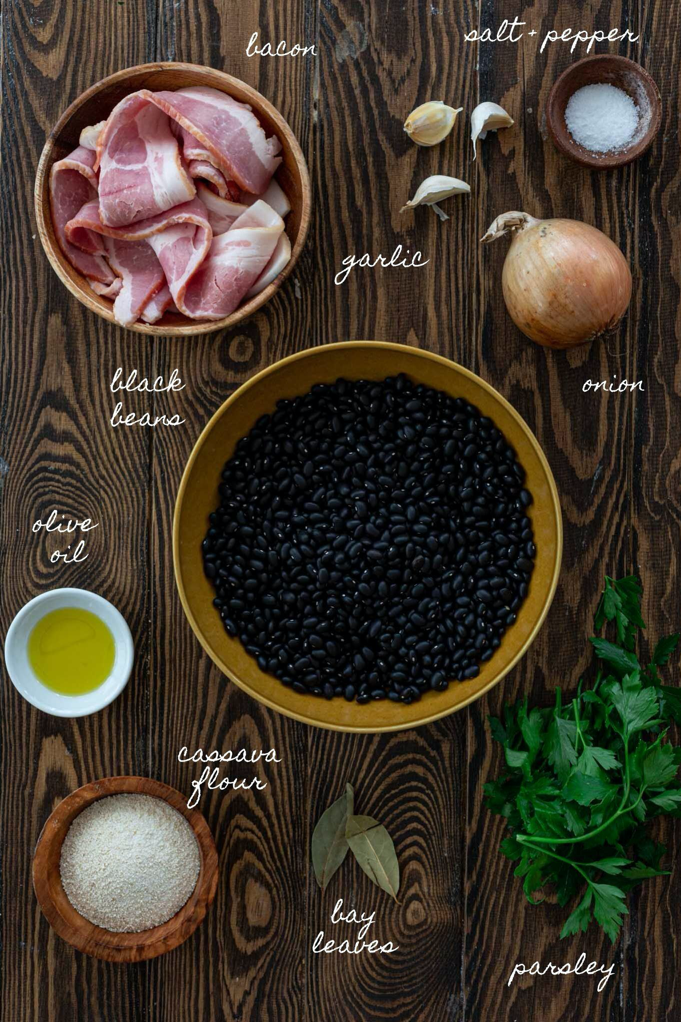
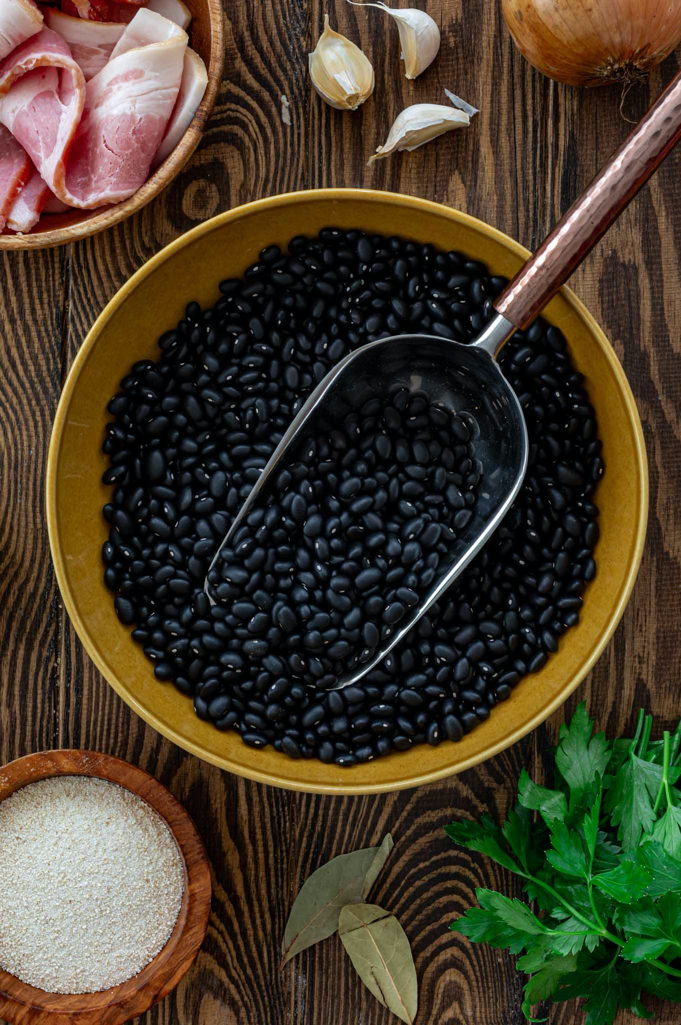
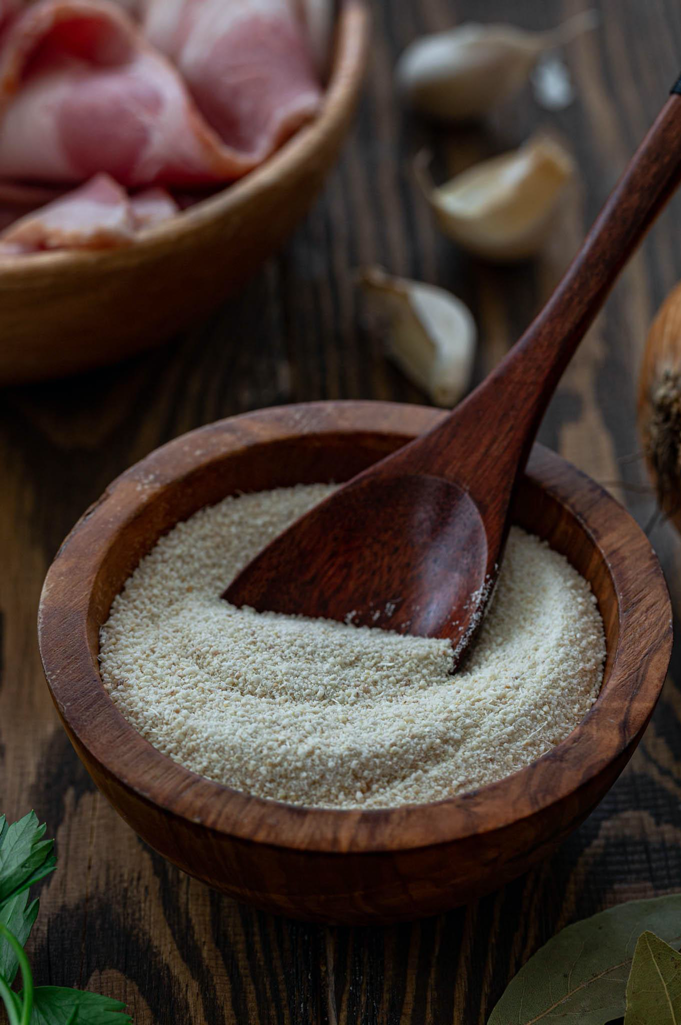
HOW TO MAKE BRAZILIAN REFRIED BEANS
There are many variations of Tutu de Feijão.
Some are very thick, others creamy. Some recipes will ask you to blend all the beans and others, like this one, will have you reserve a few cooked beans for texture.
The good news is that you can customize this recipe to make the tutu of your dreams! Whatever you do, make sure you:
- Chop the onions and garlic very small and cook them until soft and tender. That way your tutu de feijão will be creamy and you won’t be biting into crunchy onion pieces!
- Don’t add the flour all at once. My great grandmother would grab a handful of the cassava flour and slowly release it as a stream into the puréed beans, stirring constantly. That way, she controlled the thickness of the dish and would stop adding the flour when it wasn’t needed anymore.
- That being said, if your tutu de feijão ends up too thick, you can always add some water to loosen it up!
Recommended tools: Blender or potato masher, large skillet.
Here’s how I make Tutu à Mineira. As always, you can find the printable (and more complete) version at the end of this post!
- Soak the beans overnight.
- Cook the beans until very soft. You can cook on the stove or in the Instant Pot.
- Reserve 2 cups of the cooked beans and blend the rest.
- Cook the diced bacon until crispy.
- Add the onion and garlic, and cook until translucent.
- Add the reserved cooked beans and sauté with the bacon, onion and garlic.
- Add the puréed beans.
- Slowly add the cassava flour, stirring constantly, until it thickens to the desired consistency. It can be as thick or as loose as you’d like!
- Season with salt and pepper, and stir in the parsley.
DO I HAVE TO SOAK BEANS OVERNIGHT?
Soaking beans overnight helps reduce the time they have to cook and contributes to their best texture, with fewer split-open and burst beans.
However, if you forgot to soak them (happens to me often) or simply don’t have the time to do it, you can cook them from dry without soaking.
They will take longer to cook, but they will eventually get there, I promise!
CAN I USE CANNED BEANS?
Yes! While I do prefer cooking dry beans, I understand that sometimes the convenience from canned beans beats the flavor and texture that you can only get from cooking them from scratch.
You can also use leftover cooked beans to make this recipe, if you have them.
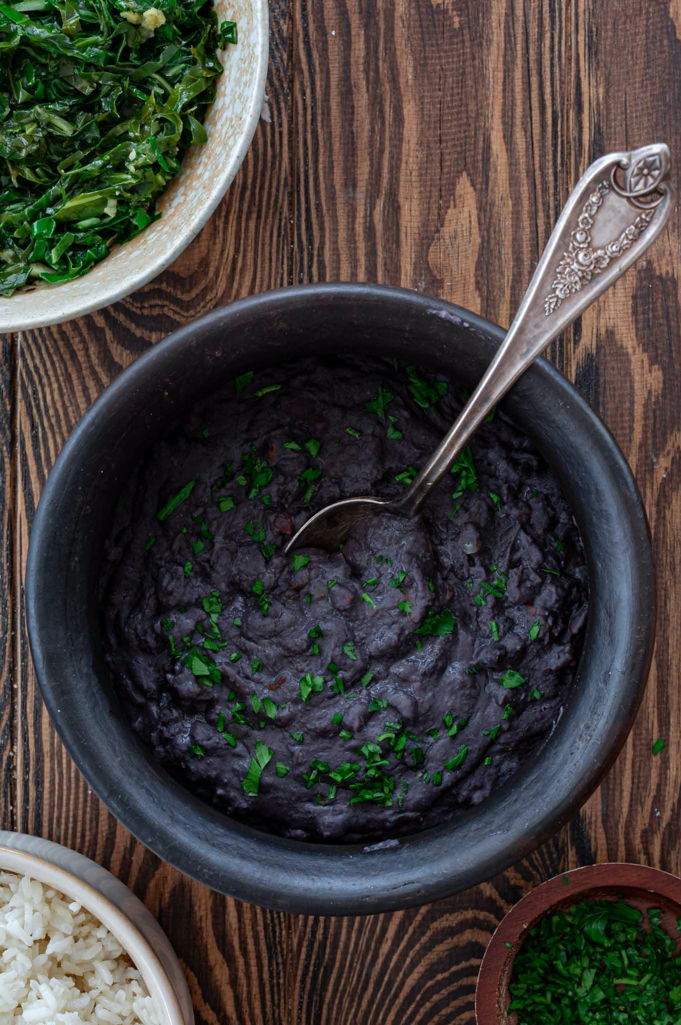
WHAT TO SERVE WITH BRAZILIAN TUTU DE FEIJÃO?
This dish is often served with white rice, collard greens and vinaigrette salsa. Picadinho (Brazilian beef stew) and fried eggs are also a must for me!
And if you’re familiar with it, Virado à Paulista (a whole-meal dish from São Paulo) calls for tutu de feijão as a component.
HOW TO REHEAT REFRIED BEANS
Got leftovers? The best way to reheat them is on the stove.
Place the refried beans in a saucepan and reheat over medium-low heat, adding water as needed to restore the original consistency.
If you must use the microwave, place the tutu de feijão in a covered container and heat on high for about 2 minutes or until warm. Stir, add a little bit of water if needed (refried beans will easily dry out when microwaved) and serve.
CAN I FREEZE TUTU À MINEIRA?
Yes, you can freeze the refried beans in an airtight container for up to 3 months.
When ready to serve, thaw overnight in the fridge and reheat. The tutu will be thick, so you will need to add water to restore the original consistency.
Yield: 6 to 8
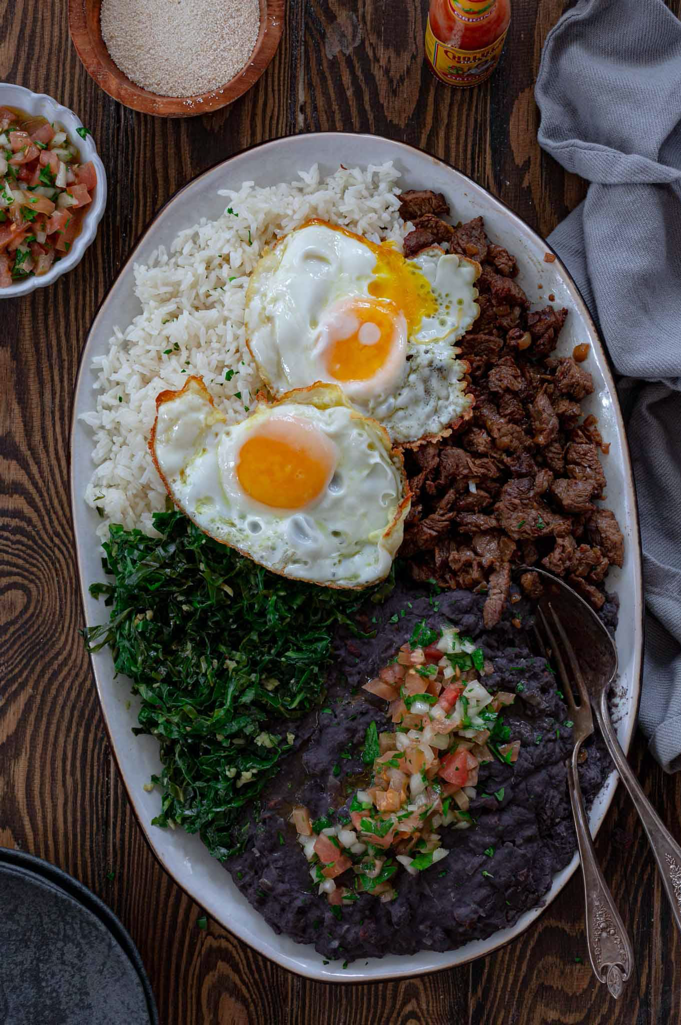
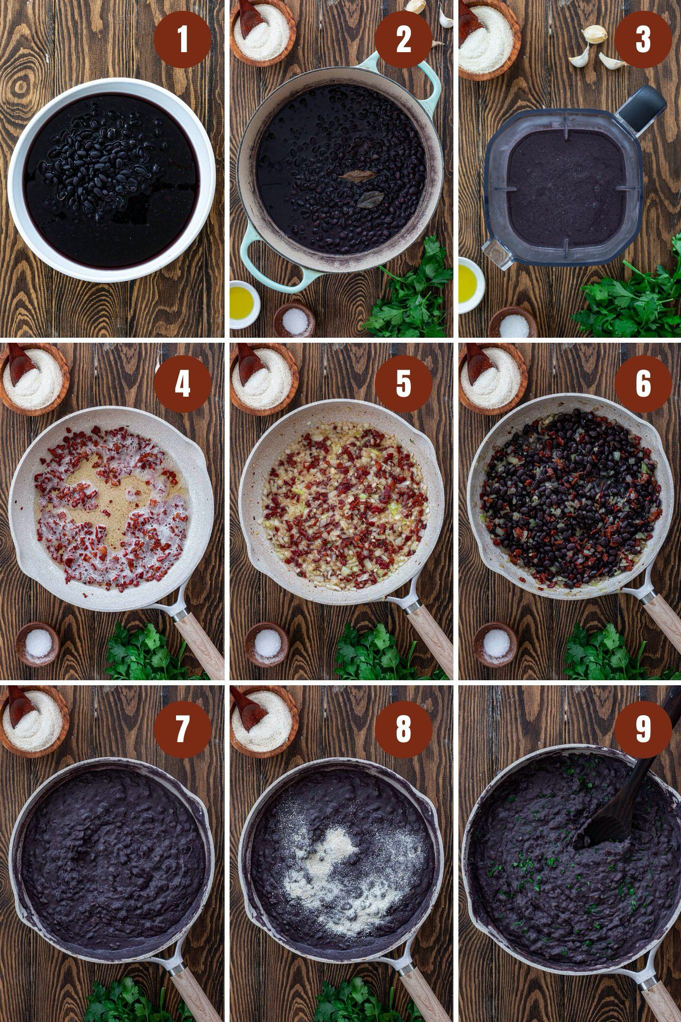
Ingredients
- 1 pound dry black beans
- 6 cups cold water, plus more for soaking
- 2 bay leaves
- 1 teaspoon olive oil
- 8 ounces thick bacon, diced
- 1 onion, finely chopped
- 3 cloves garlic, minced
- 1/4 cup cassava flour, or to taste
- Salt and freshly ground pepper, to taste
- 1/2 cup chopped parsley
Directions
- Soak the beans overnight: Place the beans in a large bowl and cover with cold water. Cover with plastic and refrigerate overnight.
- Cook the beans: Drain the soaked beans and transfer to a large Dutch oven. Add the 6 cups of water and bay leaves. Bring to a boil, over medium-high heat, then cover and reduce the heat to low. Simmer until beans are very tender, 1 hour to 1 hour 30 minutes.
- Instant Pot method: If you prefer using a pressure cooker, combine the beans, water and bay leaves in the bowl of your cooker. Cover and turn the vent to the sealed position. Cook at high pressure for 25 minutes. When done, let the steam pressure naturally release for at least 20 minutes before removing the lid.
- When beans are cooked, reserve 2 cups of the cooked beans, without liquid.
- Transfer the remaining beans with 2 cups of the cooking liquid to the jar of a blender. Blend until smooth. If you prefer a chunkier tutu de feijão, you can just mash the beans using a potato masher. Reserve.
- Heat the olive oil, over medium heat, in a large skillet. Add the bacon and cook until golden brown, 6-8 minutes.
- Add the chopped onion and garlic and cook until softened, about 2 minutes.
- Add the reserved cooked beans and sauté with the aromatics for a couple of minutes.
- Stir in the puréed beans.
- Slowly add the cassava flour, stirring constantly, until you reach the desired thickness. You might not need to use the whole amount, or you might need more. It depends on how creamy or thick you like your tutu.
- Season with salt and pepper. Stir in the chopped parsley.
- Serve immediately.
NOTES ON TUTU DE FEIJÃO
SUBSTITUTIONS:
- Black beans – You can use pinto, red or white beans instead.
- Canned beans – You can use canned or leftover cooked beans and skip steps 1-3. However, since canned beans don’t contain as much liquid as freshly cooked beans, you will probably have to add some water or broth when pureeing the beans in the blender.
- Bacon – You can substitute or add sliced or diced sausage if you’d like. Omit for a vegetarian version.
- Cassava flour – Finely ground corn flour or breadcrumbs can be used.
STORAGE:
Store in an airtight container, in the fridge, for up to 3 days.
FREEZING:
Tutu de Feijão can be frozen for up to 3 months.
REHEATING:
- Stove top (recommended): Place the refried beans in a saucepan and reheat over medium-low heat, adding water as needed to restore the original consistency.
- Microwave: Place the tutu de feijão in a covered container and heat on high for about 2 minutes or until warm. Stir, add a little bit of water if needed (refried beans will easily dry out when microwaved) and serve.
NUTRITION INFORMATION: YIELD: 8 SERVING SIZE: 1
Amount Per Serving: CALORIES: 354 TOTAL FAT: 11g SATURATED FAT: 4g TRANS FAT: 0g UNSATURATED FAT: 7g CHOLESTEROL: 28mg SODIUM: 528mg CARBOHYDRATES: 41g NET CARBOHYDRATES: 0g FIBER: 9g SUGAR: 2g SUGAR ALCOHOLS: 0g PROTEIN: 22g
Nutritional values are approximate, please use your own calculations if you require a special diet.


